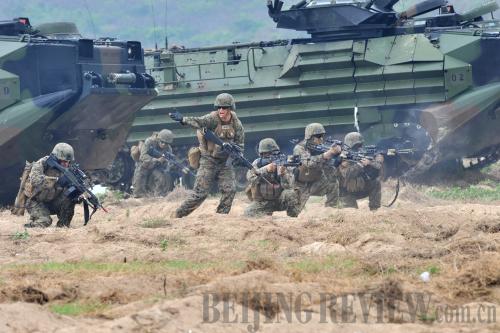|
 |
|
FREQUENT DRILLING: Soldiers practice beach landing during the Cobra Gold 2012 drill at a naval base in Thailand's Chonburi Province on February 10. Service people from seven countries including the United States, Thailand and South Korea participated in the annual joint military exercise (XINHUA) |
Shortly after the Shangri-La Dialogue and U.S. Defense Secretary Leon Panetta's visits to Asia-Pacific countries, the 2012 Rim of the Pacific (RIMPAC-2012) multinational naval exercise, the largest in history, will be staged at the end of June in the Pacific near Hawaii. The large scale naval exercise, along with Washington's recent announcement of increasing its naval presence in the Asia-Pacific, has aroused wide speculation.
On June 2, during the Shangri-La Dialogue, which was held in Singapore and attended by defense ministers and military chiefs from 28 Asia-Pacific countries, Panetta said the United States will redeploy its Navy from a 50-50 split between the Pacific and the Atlantic to 60 percent of U.S. naval forces assigned to the Pacific Ocean. Though Panetta dismissed the notion that the growing involvement of the United States in the region would pose a challenge to China, Chinese observers remain cautious.
"The RIMPAC-2012 multinational naval exercise might not directly aim at China, since it emphasizes non-traditional security," said Teng Jianqun, a research fellow with the China Institute of International Studies. "But the steps of Washington should be observed because there are always gaps between its words and deeds."
The largest naval exercise
The RIMPAC, a biennial naval exercise led by the United States, was first held in the 1970s. The original motivation was confronting the Soviet Union in the Pacific during the Cold War. Now it is the world's largest international maritime warfare exercise.
RIMPAC-2012, which is to be conducted from June 29 to August 3, will involve 22 countries, 42 ships, six submarines, more than 200 aircraft as well as 25,000 personnel. Russia, the former imaginary enemy of the drill, will participate in the exercise for the first time.
"The scale of the exercise is so big. It highlights the United States' increasing military presence in the Asia-Pacific region," said Cao Weidong, a research fellow with the People's Liberation Army (PLA) Navy's Academic Research Institute.
"The focus of the RIMPAC naval exercise has shifted from countering the former Soviet Union to non-traditional security areas such as marine navigation safety, disaster relief, rescue operations and counter-piracy," said Teng. "However, China will keep an eye on the moves of the United States."
Analysts said economic concerns are the major reasons for Washington's increasing military presence in the Asia-Pacific, but the Chinese factor cannot be ruled out.
"The Asia-Pacific region is now the engine of the world economy. The annual trade volume between the United States and the region is higher than that of the United States with any other region. But the Asia-Pacific also faces several 'hotspot issues' such as the Korean Peninsula issue and South China Sea issue. Both the dynamic economy and the unstable security situation in the region urge Washington to shift its strategic focus to the area," said Cao.
"Almost all U.S. moves are backed by its military forces. Military exercises are an effective way to show its military might," Cao added.
"From the recent speeches of U.S. President Barack Obama aiming at a second term, we can see his policy stresses expanding employment. Washington's return to the Asia-Pacific is not only a military concern. Since many Western countries are mired in financial and debt crises, the Asia-Pacific has become a new source of U.S. economic growth and employment enlargement," said Teng.
The numerous events of the RIMPAC-2012 naval exercise show the exercise also has other aims, Cao said.
| 